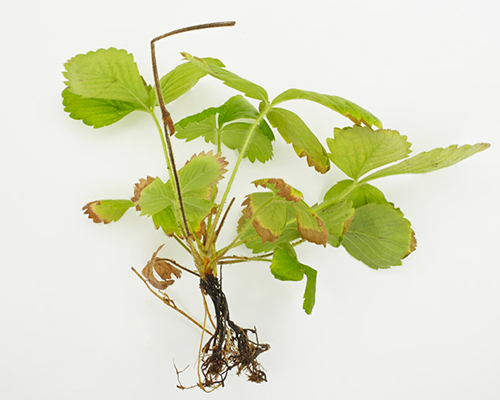There has been a significant in the number of samples of soft fruits submitted to the Fera Plant Clinic, for analysis of plant pests and diseases.
Plant-parasitic nematodes (PPNs) collectively parasitize nearly every plant species, including soft fruits, resulting in devastating adverse effects on the quality and yield of host crops. Effective management of PPNs is based on accurate detection and identification, in a bid to understand the biology of each species in the population.
Nematode damage symptoms are most noticeable at high infestation levels. However, PPNs often produce symptoms that could be mistaken for nutritional deficiency, disease or a lack of water. For this reason, many infestations go unrecorded allowing serious problems to develop in crops over time.
On strawberries, infestations could also be mistaken for mite or virus damage.
Leaf and bud nematodes
Leaf and bud nematodes (Aphelenchoides ritzemabosi and Aphelenchoides fragariae) are pathogenic ecto- and endo-parasites which thrive in glasshouse conditions, where they can attack crops such as strawberries. These types of nematode can affect hundreds of herbaceous and woody plant species. These nematodes infest and feed on crowns, growing points as well as the epidermal layer of green stems. The nematode population can survive in plant litter between seasons.
Symptoms to look for on strawberries
Damage to strawberries caused by these nematodes is most noticeable on newly formed leaves. Leaves expanding from buds infested by these nematodes are often puckered and distorted, with many of the leaflets exhibiting rough, greyish or silvery areas near the base of the main veins. Affected leaf stalks are often strongly tapered and glabrous, with the serrations on the margin of the leaves frequently distorted and reduced. In some cases, leaves can be reduced in number and size, and may be virtually absent so that only very short tapered leaf stalks remain.
These PPNs can also seriously affect flowering and fruiting with infested flowers often shrivelling during early development stages. Overhead irrigation favours the spread of an infestation by creating a film of water through which the nematodes move, while splashing can physically move nematodes from plant to plant.
When severe attacks occur, the main crown is usually killed; and weak, secondary crowns are formed. These secondary crowns often exhibit small spindly leaves with thin stalks and dark leaflets.

Stem nematode
Widely distributed in mainly temperate areas, Ditylenchus dipsaci is recognised as one of the PPNs of greatest economic importance worldwide. Around 500 plant species are known as hosts for D. dipsaci. It lives mostly as an endo-parasite in aerial parts - stems, leaves and flowers, but can also attack growing points.
Readily withstanding desiccation, this parasitic species can survive in this anhydrobiotic state for many years. When conditions permit, the nematodes migrate to host plants and invade hypocotyls or petioles, entering through stomata or penetrating the epidermis, where they moult to the adult stage and feed.
Population growth can be rapid with females capable of laying around 500 eggs, which can hatch into infective juveniles within two days. This rapid population growth can result in severe crop damage even when the initial population density is low.
Symptoms to look out for on strawberries
Leaves of infested strawberry plants are deeply crinkled, with leaf margins turned towards the under-surface and becoming brittle. In severe attacks the leaf outline becomes rounded, or irregular, with fewer marginal teeth.
In certain varieties, leaves turn darker and there may be a tendency for leaf stalks to redden. Leaf and flower stalks may thicken, become stunted and spongy in texture and often exhibit a brown core inside when cut lengthways.
Fruit is much reduced in size and, when ripe, may show pale patches and be soft and easily squashed. Runners from infested plants often show symptoms at an early stage and the stolons may be shortened and thickened.

Root-feeding nematodes
There are many different free-living nematode species that cause direct feeding damage to strawberry roots.
Root-lesion nematodes (Pratylenchus spp.) are migratory endo-parasites; they can be present in the growing media or feeding within plant roots. Pratylenchus penetrans is particularly pathogenic to strawberries and is reported to facilitate the entry of other diseases such as Verticillium.
Root feeding by needle (Longidorus spp.) and dagger (Xiphinema spp.) nematodes can cause direct damage, however certain species are also vectors of plant viruses, such as strawberry latent ringspot (SLRSV), arabis mosaic (ArMV), tomato blackring (TBRV) and raspberry ringspot (RRSV) viruses.
Symptoms to look out for on strawberries
Root-lesion nematodes feed primarily in the cortical parenchyma. Both root penetration and migration within the roots are facilitated by a combination of feeding enzymatic softening of the cell walls of the host, with damage visible as root necrosis or lesions. Typical above ground symptoms include stunting and leaf chlorosis, with the early death of older leaves.
Root feeding by needle and dagger nematodes can be characterised by gall-like swellings at the tips of primary and lateral roots and thickening of other parts of the root system. Severe stunting of strawberry has been reported following growing media infestation with Longidorus elongatus; root systems of affected plants were greatly reduced with short, swollen laterals.





